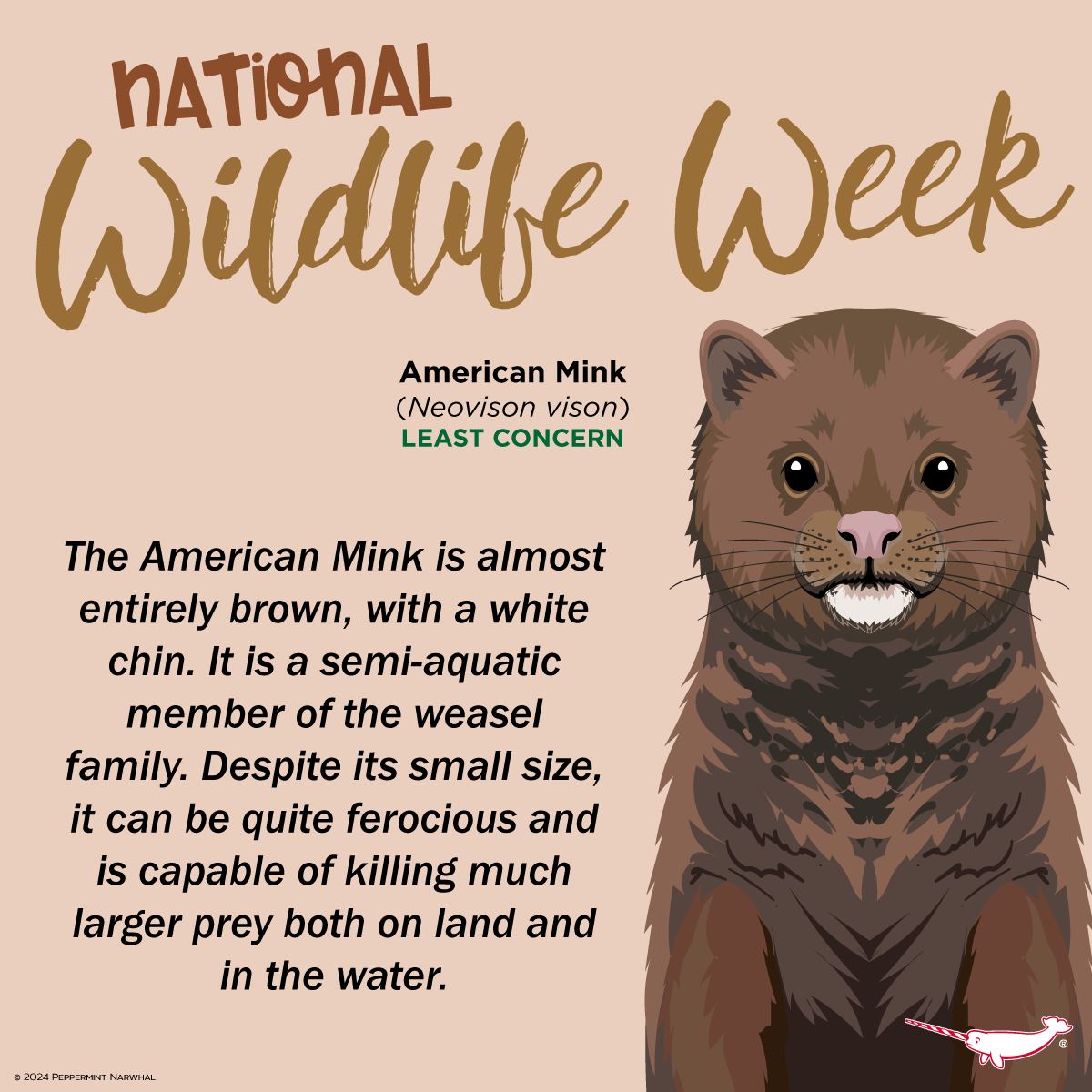– The significant ecological role of the American Mink in North American aquatic and terrestrial ecosystems.
– Challenges and threats faced by the American Mink, including human influence and environmental changes.
– Conservation efforts are necessary to protect the American Mink and similar wildlife species.
– National Wildlife Week is important for raising awareness and encouraging public participation in wildlife conservation.
– How individuals can contribute to wildlife conservation efforts during National Wildlife Week and beyond.
The American Mink (Neovison vison) is a vivid example of the intricate connections within North American ecosystems. As a semi-aquatic member of the weasel family, the American Mink exhibits remarkable adaptability, inhabiting various aquatic and terrestrial environments. Its almost entirely brown coat, accentuated by a distinctive white chin, provides camouflage within these varied habitats and highlights the species’ unique place within its ecological niche. However, despite its adaptability and prowess, the American Mink faces several challenges threatening its survival, shedding light on broader environmental issues.
The ecological role of the American Mink cannot be overstated. As a predator, it plays a crucial part in maintaining the balance of aquatic and terrestrial ecosystems. The American Mink’s diet is diverse, including fish, amphibians, and small mammals, which positions it as a pivotal figure in controlling the population sizes of these species. This dietary flexibility aids in the resilience of mink populations to changes in food availability, showcasing the species’ significant adaptive capabilities. However, this role also makes the American Mink susceptible to changes in its food sources, which can be affected by pollution, habitat destruction, and climate change.
The challenges faced by the American Mink are varied and complex. Habitat loss, primarily due to urban expansion and agricultural development, poses a significant threat to their populations. Additionally, pollution of waterways with chemical contaminants can affect the health and reproductive success of mink populations. The fur trade, although diminished, still exists and contributes to the direct exploitation of mink populations. Such human-induced threats compound natural challenges, including competition for food and territory, demonstrating the multifaceted pressures on wildlife species.
Conservation efforts for the American Mink require a multifaceted approach, acknowledging the interconnectedness of ecosystems. Protecting aquatic habitats is paramount, as water quality and availability directly impact the mink’s food sources and, consequently, its survival. Legislation regulating pollutants and enforcing stricter penalties on illegal trapping are vital steps toward ensuring the mink’s environment remains conducive to survival. Public education and engagement in conservation efforts play a crucial role. By understanding the American Mink’s ecological importance, individuals can become advocates for policies and practices that protect the mink and similar species.
National Wildlife Week is essential for raising awareness about species like the American Mink and the broader wildlife conservation issues. By dedicating time to celebrating and learning about native wildlife, the public can better appreciate the natural world and its complex interdependencies. National Wildlife Week educates and inspires action, encouraging individuals to participate in local conservation efforts, advocate for policy changes, and adopt more sustainable lifestyles.
Individuals can contribute to wildlife conservation in several impactful ways. Participating in or donating to local conservation projects, advocating for wildlife-friendly policies, and educating others about the importance of biodiversity are all meaningful actions. Reducing personal environmental footprints, such as minimizing plastic use and supporting sustainable products, directly benefits wildlife by decreasing pollution and habitat destruction.
Throughout Happy National Wildlife Week and beyond, it’s vital to remember that every effort counts in the fight to protect species like the American Mink and ensure the vibrancy of our ecosystems for future generations. Engaging with this special week is an opportunity to foster a connection with the natural world, gain knowledge about its challenges, and take part in the global effort to safeguard our planet’s incredible biodiversity.
*****
Source Description
Happy National Wildlife Week!
The American Mink (Neovison vison) is almost entirely brown, with a white chin. It is a semi-aquatic member of the weasel family. Despite its small size, it can be quite ferocious and can kill much larger prey on land and in the water.
Stay connected with us throughout National Wildlife Week for a new spotlight on animals native to the USA each day. If you have a suggestion for a species we should spotlight, please share it in the comments.
American Animal Pins:
https://www.peppermintnarwhal.com/s/search?q=north%20america
Shop www.peppermintnarwhal.com

